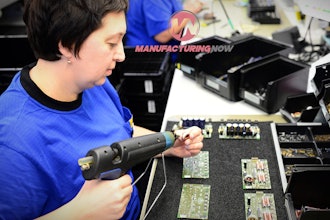Then...
Although not a great deal is known today about the life of Edmond Michel, his penchant for tinkering and inventing set the stage in the early 1920s for development of one of the longest-lasting and most highly respected brands in the history of tools.
The Frenchman, who immigrated to the United States in the early 20th century, watched in awe one day as a group of farmers hacked away at thick sugar cane stalks with large machetes. The labor seemed so difficult and intensive that Michel wondered if there was a way to make the daunting task a whole lot easier.
In 1923, after some creative thinking, testing, and tweaking, he developed a type of motorized machete by mounting a 6 in. round saw-blade on a carved wooden frame and powering it with a motor taken from a malted milk mixer.
Voila! Michel had created the world’s first electric handsaw!
 The invention attracted a great deal of attention, including that of a local New Orleans newspaper, which ran an article on the local inventor and his new time-saving device. What happened next, as they say, is history.
The invention attracted a great deal of attention, including that of a local New Orleans newspaper, which ran an article on the local inventor and his new time-saving device. What happened next, as they say, is history.
A Minneapolis land developer named Joseph Sullivan (pictured) read about the circular saw and set out to find Michel. The two men decided to go into business together, moving to Chicago and setting up the Michel Electric Handsaw Co. in 1924.
Michel left the partnership in 1926 to try his hand at other inventions and the company was renamed Skilsaw Inc. after Sullivan’s wife reportedly commented about the “skill” required to operate the new product.
By 1927, production of the newly branded Skilsaw, which had received positive reaction from contractors despite various early mechanical problems, had hit the 2,000 mark and the company turned a profit for the first time.
 A year later, the real breakthrough for Skil came with the development of its Model E circular saw (shown right). This advancement pioneered the use of a die-cast aluminum motor housing and defined in appearance what would become the benchmark of portable electric power circular saws, the Skilsaw Model 77.
A year later, the real breakthrough for Skil came with the development of its Model E circular saw (shown right). This advancement pioneered the use of a die-cast aluminum motor housing and defined in appearance what would become the benchmark of portable electric power circular saws, the Skilsaw Model 77.
In the inaugural edition of Industrial Equipment News in 1933, Skilsaw introduced a new lightweight Model W “portable saw,” labeling it “suitable for maintenance and shipping department activities” as well as “production work.”
In the 1950s, the company changed its name to Skil Corp. and by 1960 expanded outside its native borders for the first time.
Now…
In the last quarter of the 20th century, Skil became an attractive target for acquisition as it constructed a network of factories, service centers, and sales offices all around the world, making its name synonymous with power tools.
The company was acquired by the Emerson Electric Co. in 1979 and became part of S-B Power Tool Co., a joint venture between Emerson and Robert Bosch GmbH, in 1992. Bosch subsequently took 100% interest in S-B Power Tool in 1996.
Skil’s growth boomed when Bosch took over. Today, Bosch employs some 25,000 associates in 100 primary and associated facilities throughout North America.
Seven decades after Skil’s first circular saw forever changed the construction industry, the Skilsaw is still universally recognized as one of the tools that has had the greatest impact on residential construction in America. Even now, a No. 77 Skilsaw can be found on virtually every construction site in the U.S.
Today, the company’s product line features more than 80 tools, including a vast line of Skil cordless and corded power tools. Skil credits its track record for producing quality products on its extensive end-user research, consumer input, computer assisted design, and rigorous testing in laboratories and in the field.
Skil Timeline
1924 – First electric handsaw invented by Edmond Michel, who along with Joseph Sullivan establishes the Michel Electric Handsaw Co. in Chicago
 1926 – Michel leaves partnership and returns to New Orleans. Company name changed to Skilsaw Inc.
1926 – Michel leaves partnership and returns to New Orleans. Company name changed to Skilsaw Inc.
1928 – Skilsaw Model E introduced with die-cast aluminum motor housing, paving the way for the famous Model 77
1937 – The first Model 77 introduced to the market
1939 – Model E saw discontinued
1940s – PS-12 circular saw in camouflage colors developed for military use in World War II
1945 – Radial arm saw product line added
1950s – Company name changed to Skil Corp.
1960s – Skil expands internationally
1973 – Marvco Tool & Manufacturing, Inc. buys radial arm saw product line
1979 – Emerson Electric Co. acquires Skil
1992 – Emerson and Robert Bosch form S-B Power Tool Co., which includes Skil operations
1996 – Bosch takes 100% stake in S-B Power Tool Co.
2008 – Company product line features more than 80 tools



















